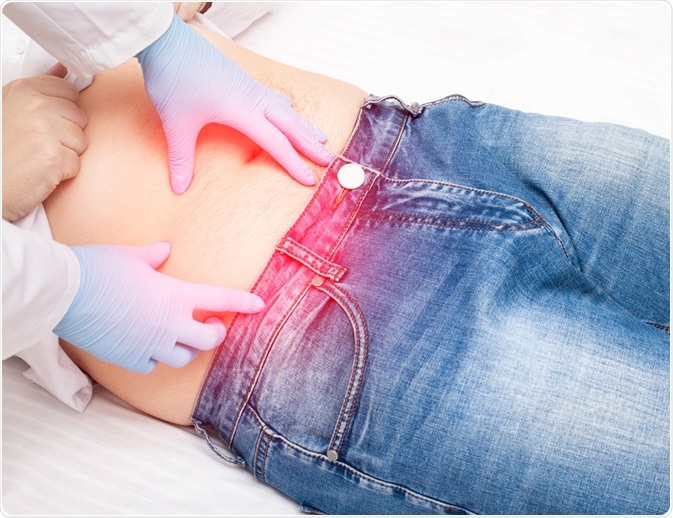Peritonitis is an inflammation of the serous membranes of the peritoneal cavity. Clinical history and attentive physical examination are key factors in making a timely diagnosis of this condition. Signs and symptoms of peritonitis depend on the severity and extent of the infection, as well as the age and general health of the patient. With these factors in mind, different diagnostic tests are pursued in order to establish a correct diagnosis.

Image Credit: HENADZI KILENT / Shutterstock.com
Clinical presentation
Abdominal pain represents the hallmark symptom of peritonitis. It can be continuous and different from tense ascites, and is often accompanied by tenderness as a common feature. The pain’s location, character, area of radiation, change over time, and provocative factors are key pieces of information in assisting with the diagnosis.
Peritoneal inflammation is usually associated with adynamic or paralytic ileus; therefore, nausea and vomiting are also common symptoms. Fever and tachycardia are often observed, whereas hypotension and hypothermia can point to disease progression and sepsis. The patient may be oliguric, which indicates a low urine output, and show signs of dehydration and shock.
Peritoneal signs denote inflammation of the parietal peritoneum secondary to an intra-abdominal process and thus consist of rebound tenderness, involuntary guarding, and extreme tenderness on palpation. Every palpation attempt should begin furthest from the area that the patient identifies as the source of the strongest pain.
Repeated physical examinations by the same physician will provide evidence of progressive peritoneal irritation. The evolution of the physical exam over time offers additional information for the diagnosis and evaluation of the patient's response to initial conservative therapy, which, together with additional diagnostic tests, indicates the need for surgical intervention.
Diagnostic approach
Laboratory studies are commonly performed, but are often non-specific in establishing the diagnosis of peritonitis. Blood samples can reveal leukocytosis with left shift and acidosis, although these measurements can be deceitful in the elderly and frequently not impressive in patients who had a recent onset of a perforated appendix.
Conventional radiographic studies are still done for diagnosing this condition. Free air may be detected on upright chest radiograph or abdominal films. Nevertheless, the finding of pneumoperitoneum by radiography has limited sensitivity in gut perforation, and the absence of free air should not delay surgical intervention in an otherwise appropriate clinical setting.
Computerized tomography (CT) scans of the abdomen and pelvis, generally with both oral and intravenous contrast, is increasingly preferred as the most sensitive and specific imaging technique for acute abdominal pain. It is much more sensitive than plain films for the detection of free air.
If spontaneous bacterial peritonitis is suspected, paracentesis should be performed, since the analysis of ascitic fluid is considered the mainstay of diagnosis. A polymorphonuclear (PMN) cell count that is greater than 250 cells per mm3 and the yield of cultures of the ascitic fluid represent the gold standard in diagnosing this condition.
In addition to a high PMN cell count, several parameters in the ascitic fluid are characteristic for patients with secondary peritonitis. These include a total protein level of greater than 1 g/dL, serum lactate dehydrogenase levels above the upper limit of normal, and a glucose level of less than 50 mg/dL.
Finally, diagnostic laparoscopy is extremely accurate in making the diagnosis of surgical peritonitis while also providing a better understanding of the underlying diseases. Female patients with gynecologic diseases can especially benefit from such an approach, which may prevent unnecessary laparotomy.
References
- https://www.jgld.ro/jgld/index.php/jgld
- http://www.ncbi.nlm.nih.gov/books/NBK6950/
- https://www.wjgnet.com/
- http://www.ncbi.nlm.nih.gov/pmc/articles/PMC4197493/
- http://www.ncbi.nlm.nih.gov/pmc/articles/PMC4013728/
- Wyers SG, Matthews JB. Surgical Peritonitis and Other Diseases of the Peritoneum, Mesentery, Omentum, and Diaphragm. In: Feldman M, Friedman LS, Brandt LJ, editors. Sleisenger and Fordtran’s Gastrointestinal and Liver Disease: Pathophysiology, Diagnosis, Management. Elsevier Health Sciences, 2015; pp. 636-648.
Further Reading